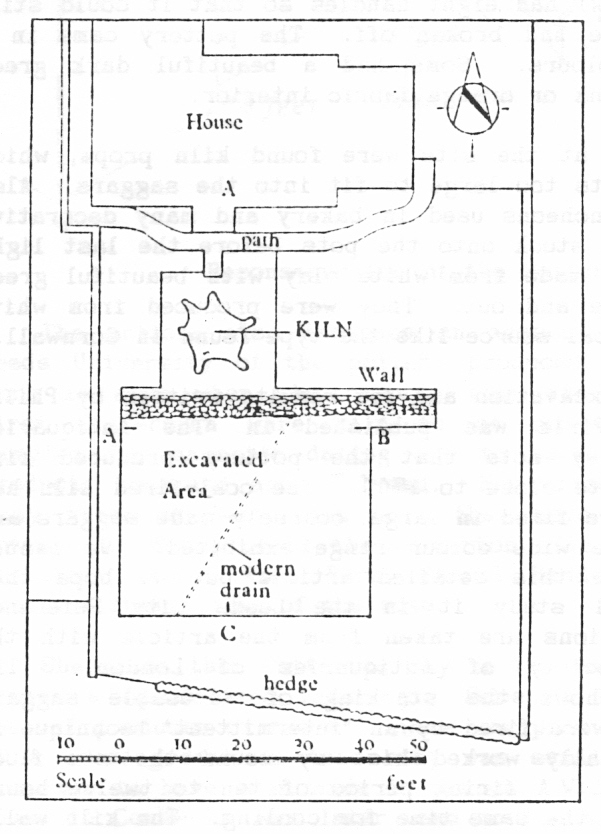Back to the Main Historical Society page
Back to the Barwicker Contents page
A Mediaeval Pottery Kiln
from The Barwicker No.27
September 1992
In a previous article (see 'The Barwicker' No.22) I described
Potterton Grange Farm when I and my husband lived there from 1959
to 1973. In about 1960, I tried to make a garden on the area to
the south of the house but I found myself digging up a number of
whole or broken earthenware objects like plant pots. I used five
of them to grow plants in, not then realising their archaeological
importance.
One day in the summer of 1962, a gentleman called and asked if
he could have permission to look along the edge of the top field
leading from the farmhouse to Morgans Cross. He had found some
pieces of the earthenware objects which I later discovered were
called 'saggars'. I took him and showed him where I had dug up the
saggars and I explained that I was trying to dig
a garden. He looked at me and said, 'Please, please, please, don't
dig any more'.
 |
| Site location |
He was Philip Mayes from Leeds University and he was so excited that when he tried to explain, he went into so much historical
detail that it went over my head at first and I could not visualise what he was talking about.
He asked if he could excavate the site and following a family conference, the plan
was agreed. All the top soil was removed from the site and tipped onto the
garden to the east side of the area investigated. The excavation revealed a
late mediaeval pottery kiln.
I was surprised to learn that the kiln had been fired with
coal, which was shown when the coke debris was sent to London and
centrifugally spun to separate it. Scientific dating showed that
the kiln was last fired in about 1500. The kiln was shaped like a
beehive with a vent at the top. The pots were fired inside the
saggars which were turned upside down from the way I had used
them as plant pots. The saggars protected the pots during the
firing. The pieces of pot dug out were investigated by Hiss Pirie
of the Leeds Museum. In the evening or at weekend we would sit
round our kitchen table and she would look at the pieces I had dug
up. It was a real privilege to sit and watch her at work as she
fitted pieces together to make a part or a whole pot.
The pots were of many different shapes and sizes. One
incomplete jug was about 18 inches high and when I asked Miss
Pirie what it would be used for she said it was a water carrier.
The pots were what is called Cistercian ware. There were some
multi-handled drinking vessels, which were made because the
Cistercian monks had a rule that they must use two hands when
drinking. One small bowl had eight handles so that it could still
be used even after some had broken off. The pottery came in a
surprising range of colours. Some had a beautiful dark green
external glaze over a pink or orange fabric interior.
Amongst the debris at the site were found kiln props, which
were used to support pots too large to fit into the saggars. Also
found were pieces of pancheons used in bakery and many decorative
oval 'slips', which were stuck onto the pots before the last light
firing. Some pots were made from white clay with beautiful green
or yellow glazing inside and out. They were produced from white
clay from an unknown local source like the type found in Cornwall.
An account of the excavation and its results written by Philip
Mayes and Elizabeth Pirie was published in 'The Antiquaries
Journal' of 1966. They note that the pottery produced fine
Cistercian ware at a date close to 1500. The coal-fired kiln had
six flues. The pots were fired in large, coarsely-made saggars and
were remarkable for the wide colour range exhibited. We cannot
satisfactorily summarise this detailed article but we hope that
interested readers will study it in the Leeds City Reference
Library. The illustrations are taken from the article with the
permission of the Society of Antiquaries of London. The
reconstruction below shows the stacking of re-usable saggars
within the kiln, which were fired by an 'intermittent' technique in
which the stoker gradually worked his way round the six flues
adding coal as required. A firing period of ten to twelve hours
was probable with about the same time for cooling. The kiln walls
were then broken to remove the pots in their saggars. It was
rebuilt for the next firing.
The article also includes an account by Jean Le Patourel of
Leeds University of the pottery produced. The importance of the
work is seen when she reports that the Potterton kiln was the
first Cistercian ware kiln to be completely excavated, to be
sampled for magnetic dating and to have the whole range of its
products recorded and analysed. Her article has diagrams of the
many types of Cistercian ware that have been found, not all at
Potterton. Products of the Potterton kiln have been recognised at
Kirkstall Abbey. Rest Park. Chapel Haddlesey and Newstead. all
within fifteen miles of the site.
She notes that Potter ton may be regarded as a specialised kiln
wi thin a specialised industry. Some of the most unexpected and
unusual products of the kiln were the products of white clay. Part
of a chafing-dish in this clay was similar to dishes originally
presumed to have been made in France. White clay. similar to that
found in Cornwall. was later used in the manufacture of the famous
eighteenth century 'Leeds ware'.
Back to the top
Back to the Main Historical Society page
Back to the Barwicker Contents page

